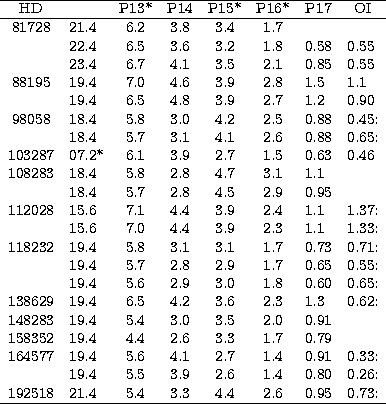 Equivalent widths given in A. |
 Equivalent widths given in A. |
To better use the descriptions of the infrared spectra taken in 1989, these have
been measured. The measures, as far as they concern stars observed in this
paper, are listed in Table 5. This should replace advantageously the former
verbal descriptions.
HD 77190. A shell was present in 1973; in
1983 at H![]() and now no traces of it are
seen.
and now no traces of it are
seen.
HD 81728. In 1977 Andersen & Nordstroem called the object a
"possible shell
star"; in 1984 H3 had a sharp absorption core upon a broad photospheric line; in
1988 the shell was definitely present and is weakly present now. This agrees
with the O I line which is weaker now than in 1989. The Ca II profiles are also
broader.
HD 88195. The shell was not noticed by
Cowley et al. (1969), neither by
Dworetsky (1974) It was detected by
Andersen & Nordstroem (1977) and was present in 1984
in the H3 region under the form of large photospheric absorption line, weak
central emission and strong central reversal. The shell was present in a
weakened form in 1988. It continues to be present and O I 8446 is weaker now
than in 1988.
HD 98058. With some variations in intensity, the shell is present since 1973 at
least. However in 1984 the H3 line was normal. Comparing equivalent widths of
1988 and 1996, Paschen lines have remained constant, Ca II has strengthened and
probably also O I.
HD 103287. The emission phenomena in this star seem to concentrate in the Ca II
and H3 lines. O I also varied, passing from 0.46 in 1989 to 0.68 in 1996.
Notice that on 1983 and 1984 the H3 line was strongly variable both in
equivalent width and in structure; on some plates a weak central emission was
present.
HD 108283. (=14 Com). This is a star with a rather stable shell. We observed no
perceptible changes in the Paschen region. In 1983-4 the H3 profile was normal,
without structure.
HD 112028. This is also a rather stable shell, with no changes in the Paschen
region. In 1983-4 the H3 line had a strong absorption profile, with a central
reversal and superposed central reversal and V/R variations; in 1996 we find a
sharp absorption core.
HD 118232. The shell was described by Abt & Moyd (1973),
disappeared afterwards
(1977-1988) and seems to be back now. Comparing the Paschen region in 1989 and
1996, no noticeable changes are seen. Notice also that the H3 profile was
normal in 1983-4 and in 1996, but at the latter date its equivalent width is too
large for the type.
HD 138629. Apparently a weak shell, stable over the years. H3 has decreased
from 11.6 in 1986 to 10.5 and the same is true for P 14 between 1989 and 1996.
Notice also that the H3 line in 1983-4 showed sometimes asymmetric profiles,
which conducted to a search of short term variability which was inconclusive. In
1996 the equivalent width of the line is too large for the spectral type.
HD 148283. The shell is rather weak but seems stable. O I seems to have
diminished. No changes in the Paschen region between 1989 and 1996.
HD 151431. Apparently no variations between 1991 and our plates.
HD 158352. The shell was described by
Abt & Moyd (1973); Dominy & Smith (1977)
and Slettebak (1982). The latter author denoted a weakening of the features,
which by 1988 had disappeared except for the cores in the blue Ca II lines. With
respect to 1989, we find a strengthening of the Ca II lines and of O I 8446.
HD 164577. No traces of a shell. The star had only a weak centrally reversed
emission in H3. In 1983-4 the H3 line showed a structure: with central emission
and central reversal and V/R variations. In the Paschen region we find a
strengthening of O I 8446 by a factor of almost two in 1996 with respect to
1988.
HD 192518. Apparently a stable shell with some variations in strength over the years. In the Paschen region we find a strengthening of Ca II and O I 8446 from 1989 to 1996.
This discussion shows that we need considerably more observations to say something definitive about the variability of the group. We found strong variability (i.e. disappearance or appearance) in seven stars (HD 77190, 81728, 88195, 103287, 118232, 158352 and 164577), stable shells (with some intensity variations) in six cases and one uncertain case. In the seven cases of variability, some time scales are of the order of decades - but since this corresponds more or less to the time interval between the different surveys this is less significant than one would like. However in at least one case there is evidence of changes on a short time scale, namely HD 138629 for which we found variations over a few days. We find thus at least eight stars out of fourteen to be variable, i.e. 57%. However if we apply the variability count strictly to the sample of 1988 and 1996, we find only three stars in which the situation has changed, i.e. 25%. Thus a close following of the stars will reveal more variations, especially if the variations can be documented by measures of equivalent widths. In successive papers the percentage of stars found to be variable has increased, and is now practically two thirds of all objects.
Copyright The European Southern Observatory (ESO)